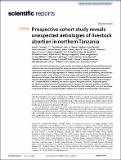Prospective cohort study reveals unexpected aetiologies of livestock abortion in northern Tanzania
| dc.contributor.author | Thomas, Kate | |
| dc.contributor.author | Kibona, Tito | |
| dc.contributor.author | Claxton, John | |
| dc.contributor.author | de Glanville, William | |
| dc.contributor.author | Lankester, Felix | |
| dc.contributor.author | Amani, Nelson | |
| dc.contributor.author | Buza, Joram | |
| dc.contributor.author | Carter, Ryan | |
| dc.contributor.author | Chapman, Gail | |
| dc.contributor.author | Crump, John | |
| dc.contributor.author | Dagleish, Mark | |
| dc.contributor.author | Halliday, Jo | |
| dc.contributor.author | Hamilton, Clare | |
| dc.contributor.author | Innes, Elisabeth | |
| dc.contributor.author | Katzer, Frank | |
| dc.contributor.author | Livingstone, Morag | |
| dc.contributor.author | Longbottom, David | |
| dc.contributor.author | Millins, Caroline | |
| dc.contributor.author | Mmbaga, Blandina | |
| dc.contributor.author | Mosha, Victor | |
| dc.contributor.author | Nyarobi, James | |
| dc.contributor.author | Nyasebwa, Obed | |
| dc.contributor.author | Russell, George | |
| dc.contributor.author | Sanka, Paul | |
| dc.contributor.author | Semango, George | |
| dc.contributor.author | Wheelhouse, Nick | |
| dc.contributor.author | Willett, Brian | |
| dc.contributor.author | Cleaveland, Sarah | |
| dc.contributor.author | Allan, Kathryn | |
| dc.date.accessioned | 2023-09-11T07:54:48Z | |
| dc.date.available | 2023-09-11T07:54:48Z | |
| dc.date.issued | 2022-07-08 | |
| dc.identifier.uri | https://doi.org/10.1038/s41598-022-15517-8 | |
| dc.identifier.uri | https://dspace.nm-aist.ac.tz/handle/20.500.12479/1946 | |
| dc.description | This research article was published by Springer Nature Limited in 2022 | en_US |
| dc.description.abstract | Livestock abortion is an important cause of productivity losses worldwide and many infectious causes of abortion are zoonotic pathogens that impact on human health. Little is known about the relative importance of infectious causes of livestock abortion in Africa, including in subsistence farming communities that are critically dependent on livestock for food, income, and wellbeing. We conducted a prospective cohort study of livestock abortion, supported by cross-sectional serosurveillance, to determine aetiologies of livestock abortions in livestock in Tanzania. This approach generated several important findings including detection of a Rift Valley fever virus outbreak in cattle; high prevalence of C. burnetii infection in livestock; and the first report of Neospora caninum, Toxoplasma gondii, and pestiviruses associated with livestock abortion in Tanzania. Our approach provides a model for abortion surveillance in resource-limited settings. Our findings add substantially to current knowledge in sub-Saharan Africa, providing important evidence from which to prioritise disease interventions. | en_US |
| dc.language.iso | en | en_US |
| dc.publisher | Springer Nature Limited | en_US |
| dc.subject | Diseases | en_US |
| dc.subject | Microbiology | en_US |
| dc.subject | Systems biology | en_US |
| dc.title | Prospective cohort study reveals unexpected aetiologies of livestock abortion in northern Tanzania | en_US |
| dc.type | Article | en_US |

